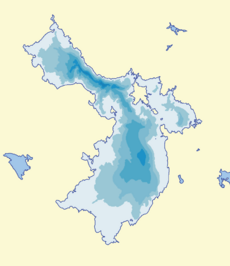Lake Sigismund
| Lake Sigismund | |
|---|---|
| Sigismundsee (Hesurian) Sigmundmier (Temarian) Lacu Sigismund (Cuthish) | |
 Detail map | |
| Location | Cuthland, Lilienburg, Mascylla, Temaria |
| Type | Glacial lake |
| Primary inflows | Lanne River, Erms, Stith, Meer, Wid |
| Primary outflows | Blaugold River, Massel-Alsing Canal |
| Catchment area | 128,000 km2 (49,300 sq mi) |
| Basin countries | Cuthland, Lilienburg, Rovina, Mascylla, Temaria, Valtriva |
| Max. length | 408 km (253.5 mi) |
| Max. width | 118 km (73.3 mi) |
| Surface area | 32,324 km2 (12,480 sq mi) |
| Average depth | 112 m (367 ft) |
| Max. depth | 567 m (1,860 ft) |
| Water volume | X km3 (X cu mi) |
| Residence time | 8.1 years |
| Shore length1 | 1,600 km (994 mi) |
| Surface elevation | 260 m (853 ft) |
| Frozen | Occasionally in winter |
| Islands | 9 |
| Settlements | Lansbruck, Alderport, Lilienburg City, Achsburg, Mackrau, Linghope, Middelpool, Konreid, Rothenthur |
| 1 Shore length is not a well-defined measure. | |
Lake Sigismund (Hesurian: Sigismundsee, Temarian: Sigmundmier, Cuthish: Lacu Sigismund), also known as the Sigismund Sea, is a lake located in the centre of the Telmerian peninsula, south-west of the Gasselian, Weisenian and Holnian Mountains and north of the Central Temarian Basin, shared between Temaria and Cuthland to the west, Lilienburg to the south-west, and Mascylla to the east. With a size of 32,324 km2 (12,480 sq mi), it is mainland Berea's largest inland body of water, the largest lake in Telmeria and the world's biggest freshwater lake. The lake has its primary outflow to the north-east with the Blaugold River; however, the Massel-Alsing Canal in Temaria connects the Mogd River with the lake. It has also one of the largest catchment areas for a lake worldwide, the single largest in Telmeria, and its shores are globally the most populated with around 27 million inhabitants.
Its creation can be attributed to the last major ice age, as glaciers carved out the basin to form the depression that would later be filled by the melt water of the ice cap as it melted away around 11,500 years ago. The sea bed in the northern part reaches as low as 567 m (1,860 ft) below sea level, which makes it the third lowest natural depression in the world.
Its shorelines are governed by the Mascyllary states of Elpsia and Holnia, the Lilienburger boroughs of Lindau, Wilhelmsdorf, Schiltach, Eschensee-Osthafen, and Lilienwald-Sigismundsee, the Cuthish provinces of Alderportshire, Linghopeshire, and Middlepoolshire, and the Temarian cantons of Hauptstadtkanton-Achsburg and Südgassern. Lake Sigismund is generally regarded as one of the major locations of Telmerian culture, history, religion, and economic development. The lake is tied to an extensive waterway system and thus is the largest transportation hub in Telmeria, and a key economic region for all neighbouring states. Struggling for hegemony over the lake has led to multiple conflicts and wars, the most notable of which include the Second Cutho-Mascyllary War and Great War. Maritime borders in the lake have been subject to diplomatic debate and the exploitation of resources an ongoing political, economic, and ecological issue.
